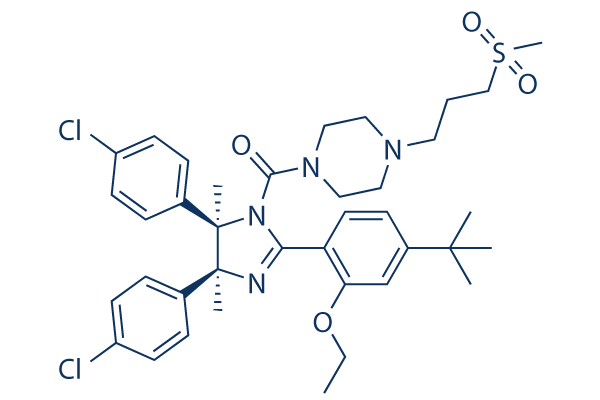| Description: |
RG7112 is the first clinical and orally available MDM-2/p53 inhibitor designed to occupy the p53-binding pocket of MDM2, with the Kd value of 11 nM. |
| Target: |
Kd: 11 nM (MDM2)[1] |
| In Vivo: |
RG7112 is highly synergistic with androgen deprivation in LNCaP xenograft tumors. RG7112 (25-200 mg/kg, p.o.) to human xenograft-bearing mice at nontoxic concentrations causes dose-dependent changes in proliferation/apoptosis biomarkers as well as tumor inhibition and regression[2]. |
| In Vitro: |
RG7112 (2.5μM) is more active against proliferation of liposarcoma cells, and especially those with wild-type p53. Treatment of cells with either Nutlin-3A or RG7112 induces cell-cycle arrest and apoptosis in the p53-WT cell line 93T449. RG7112 treatment reduces cell viability much more than Nutlin-3A in HT-1080, SW684, 93T449, and SW872 cells[1]. RG7112 shows potent antitumor activity against a panel of solid tumor cell lines. Treatment of cancer cells expressing wild-type p53 with RG7112 activates the p53 pathway, leading to cell-cycle arrest and apoptosis[2]. |
| Cell Assay: |
Sarcoma cells are seeded in 96-well E-plates with integral sensor electrode arrays. After 24 hrs, the cells are treated with different RG7112 concentrations and cell proliferation is monitored noninvasively, in real-time and label-free using the xCELLigence Real-Time Cell Analyzer for up to 72 hours. The 96-well E-plates used with the xCELLigence system have gold electrodes on their bottom surface, serving as sensors of alternating current modified by the number of adherent cells and cell status (including cell viability, morphology, and adhesion). A dimensionless parameter termed cell index (CI) is derived as a relative change in measured electrical impedance to represent cell status. CI normalized to the time of medium switch/treatment is presented in xCELLigence recordings. |
| Animal Administration: |
For studies with hormone-dependent LNCaP xenografts, castrated male Balb/c nude are implanted with 12.5 mg sustained-release testosterone pellets 5 days before subcutaneous inoculation with 1×107 cells suspended in 0.2 mL of Matrigel:PBS. Mice are randomized into treatment groups (n=10 per group) when mean tumor volume reaches approximately 150 to 400 mm3. Mice receive either vehicle (1% Klucel LF/0.1% Tween 80) or RG7112, administered as an oral suspension at the dose indicated (25-200 mg/kg). For assessment of androgen ablation treatment in combination with RG7112 in LNCaP xenograft-bearing mice, testosterone pellets are removed under ketamine/xylazine anesthesia. Tumor volume is monitored by caliper measurement and body weights are recorded 2 to 3 times weekly. |
| References: |
[1]. Obrador-Hevia A, et al. RG7112, a small-molecule inhibitor of MDM2, enhances trabectedin response in soft tissue sarcomas. Cancer Invest. 2015;33(9):440-50.
[2]. Tovar C, et al. MDM2 small-molecule antagonist RG7112 activates p53 signaling and regresses human tumors in preclinical cancer models. Cancer Res. 2013 Apr 15;73(8):2587-97.
[3]. Verreault M, et al. Preclinical Efficacy of the MDM2 Inhibitor RG7112 in MDM2-Amplified and TP53 Wild-type Glioblastomas. Clin Cancer Res. 2016 Mar 1;22(5):1185-96.
[4]. Makii C, et al. MDM2 is a potential therapeutic target and prognostic factor for ovarian clear cell carcinomas with wild type TP53. Oncotarget. 2016 Nov 15;7(46):75328-75338. |






















